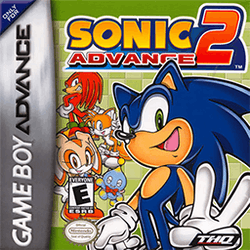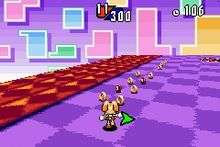Sonic Advance 2
| Sonic Advance 2 | |
|---|---|
 North American cover | |
| Developer(s) |
Dimps Sonic Team |
| Publisher(s) | |
| Distributor(s) |
|
| Director(s) | Akinori Nishiyama |
| Producer(s) |
Yuji Naka Hiroshi Matsumoto |
| Artist(s) | Yuji Uekawa |
| Composer(s) |
Tatsuyuki Maeda Yutaka Minobe Teruhiko Nakagawa |
| Series | Sonic the Hedgehog |
| Platform(s) | Game Boy Advance |
| Release date(s) | |
| Genre(s) | Platformer |
| Mode(s) | Single player, multiplayer |
Sonic Advance 2 (ソニックアドバンス2 Sonikku Adobansu Tsū) is a 2002 handheld platform video game developed by Dimps and Sonic Team, and published in Japan by Sega, in North America by THQ, and in Europe by Infogrames for the Game Boy Advance. The game was released in Japan on December 19, 2002, in North America on March 9, 2003, and in PAL Regions on March 28, 2003. It is the sequel to Sonic Advance, and is based on a modified version of its game engine. Gameplay consists of the player defeating "zones" as one of five unlockable characters, each with their own unique attributes. After each zone is completed, the player faces Doctor Eggman, the story's antagonist, in a boss battle.
The game was later released on the Wii U's Virtual Console in Japan in February 2016.[1]
Gameplay
Sonic Advance 2 is a 2D side-scrolling platform game, similar to earlier games in the series such as the first Sonic the Hedgehog. The player controls Sonic the Hedgehog, who can unlock Cream the Rabbit and her Chao named Cheese, Tails, and Knuckles the Echidna after defeating Doctor Eggman in specific boss battles.[2] A fifth character, Amy Rose, can be unlocked after completing all of the game with each character.[2] Each character has their own unique moves and abilities; for example, Cream and Tails can fly, while Amy can swing a hammer throughout levels.[2]

In the tradition of Sonic games, gameplay consists of moving quickly through levels, collecting rings and defeating enemies. However, players will quickly notice each stage is noticeably larger than past stages in the series. Levels in the game are divided into seven "zones",[3] each consisting of two acts of normal gameplay then a boss battle, where the player fights Doctor Eggman[4] in order to stop Eggman from "building a Dr. Eggman Empire by kidnapping the animals and turning them into robots".[5] The player collects rings as a form of health; when the player is attacked by an enemy, their rings bounce in all directions. If the player is hit by an enemy and has no rings, they lose a life.[6] The player can also collect seven "special rings" to access "special stages",[6] where Chaos Emeralds are found. "Special stages" are on a 3D plane,[4] where the character tries to obtain a set number of rings before time runs out in order to collect a Chaos Emerald. After beating all zones and finding all seven Chaos Emeralds with Sonic, an alternate final act is unlocked.[3] When all of the Chaos Emeralds are collected with the other characters, a sound test feature and a boss time-attack feature are unlocked, along with the Tiny Chao Garden, where toys for Cream's Chao, Cheese,[2] can be purchased with rings earned in-game.[6] Various mini-games can also be played in the Tiny Chao Garden.[7]
Other game modes include a "time-attack" mode where the player tries to beat a specific act in the shortest amount of time,[8] and a multiplayer mode, where players can race each other through unlocked acts.[4]
Development
Sonic Advance 2 was revealed at the Tokyo Game Show in September 2002, along with a new character in the Sonic series, Cream the Rabbit, that would be available for play in-game.[9]
Reception
| Reception | ||||||||||||||||||||||||||
|---|---|---|---|---|---|---|---|---|---|---|---|---|---|---|---|---|---|---|---|---|---|---|---|---|---|---|
| ||||||||||||||||||||||||||
Sonic Advance 2 was released in Japan on December 19, 2002, in North America on March 9, 2003, and in the PAL region on March 28, 2003.[14] The game sold approximately 175,000 copies in Japan,[15] 740,000 copies in the United States,[16] and 100,000 copies in the United Kingdom,[17] for a total of approximately 1,015,000 units sold, making Sonic Advance 2 one of the best-selling games for the Game Boy Advance.
The game received generally positive reviews upon its release; review aggregator sites GameRankings and Metacritic gave Sonic Advance 2 an 85.25% and an 83 out of 100, respectively.[10][11] GameSpot reviewer Frank Provo gave the game an 8.2 out of ten, stating "Sonic Advance 2 is easily the toughest 2D Sonic game ever made",[6] where as GameSpy reviewer Christian Nutt called Sonic Advance 2 "a solid adventure with some niggling flaws", and gave the game a 3 out of 5.[13] IGN reviewer Craig Harris, who gave Sonic Advance 2 a 9 out of 10, drew comparisons between the game and its predecessor, while also stating "the graphics are more vibrant with tons more character animation to give the sequel a lot more personality."[2] 1UP.com agreed, stating "the game plays like classic Sonic games", and "visually, Sonic Advance 2 is vibrant and colorful".[3] Allgame reviewer Scott Alan Marriott criticized the game, saying "[Sonic Advance 2] doesn't have is originality or depth, making this sequel more subsonic than supersonic".[4] Nintendo Power gave the game an 82, while stating "[Sonic Advance 2] may not present significant advances beyond his GBA debut, but it's a solid action title".[11]
References
- ↑ "ソニック アドバンス 2 | Wii U | 任天堂" (in Japanese). Retrieved 2016-08-16.
- 1 2 3 4 5 6 Craig James (March 14, 2003). "Sonic Advance 2". IGN. Retrieved December 26, 2011.
- 1 2 3 4 "Sonic Advance 2 review". 1UP.com. October 13, 2005. Retrieved December 26, 2011.
- 1 2 3 4 5 Scott Alan Marriott. "Sonic Advance 2". Allgame. Retrieved December 26, 2011.
- ↑ Sonic Team (2003). Sonic Advance 2 Instruction Booklet. THQ. p. 2.
- 1 2 3 4 5 Frank Provo (April 7, 2003). "Sonic Advance 2 Review". GameSpot. Retrieved December 26, 2011.
- ↑ "THQ and SEGA Announce Sonic Advance 2 for Game Boy Advance". THQ. Yahoo! Finance. January 30, 2003. Archived from the original on April 10, 2003. Retrieved December 27, 2011.
- ↑ Tom Bramwell (April 4, 2003). "Sonic Advance 2 Review". Eurogamer. Retrieved December 27, 2011.
- ↑ Mike Sklens (September 20, 2002). "Brand new character in Sonic Advance 2". Nintendo World Report. Retrieved December 29, 2011.
- 1 2 "Sonic Advance 2". GameRankings. Retrieved December 26, 2011.
- 1 2 3 4 "Sonic Advance 2". Metacritic. Retrieved December 26, 2011.
- ↑ ゲームボーイアドバンス - ソニックアドバンス 2. Weekly Famitsu. No.915 Pt.2. Pg.121. 30 June 2006.
- 1 2 Christian Nutt (March 31, 2003). "Sonic Advance 2". GameSpy. Retrieved December 26, 2011.
- ↑ "Japanese total sales from 21 March 2001 to 30 December 2007". Famitsu. Archived from the original on July 10, 2008. Retrieved December 27, 2011.
- ↑ "The Century's Top 50 Handheld Games". Next Generation Magazine. August 2, 2006. Retrieved December 27, 2011.
- ↑ "ELSPA Sales Awards: Silver". Entertainment and Leisure Software Publishers Association. Archived from the original on February 21, 2009. Retrieved December 27, 2011.
External links
- Official website (Japanese)